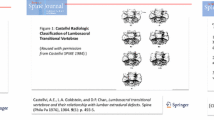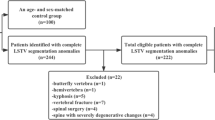Abstract
Purpose
Anatomical landmarks and their relation to the lumbar vertebrae are well described in subjects with normal spine anatomy, but not for subjects with lumbosacral transitional vertebra (LSTV), in whom correct numbering of the vertebrae is challenging and can lead to wrong-level treatment. The aim of this study was to quantify the value of different anatomical landmarks for correct identification of the lumbar vertebra level in subjects with LSTV.
Methods
After IRB approval, 71 subjects (57 ± 17 years) with and 62 without LSTV (57 ± 17 years), all with imaging studies that allowed correct numbering of the lumbar vertebrae by counting down from C2 (n = 118) or T1 (n = 15) were included. Commonly used anatomical landmarks (ribs, aortic bifurcation (AB), right renal artery (RRA) and iliac crest height) were documented to determine the ability to correctly number the lumbar vertebrae. Further, a tangent to the top of the iliac crests was drawn on coronal MRI images by two blinded, independent readers and named the ‘iliac crest tangent sign’. The sensitivity, specificity and the interreader agreement were calculated.
Results
While the level of the AB and the RRA were found to be unreliable in correct numbering of the lumbar vertebrae in LSTV subjects, the iliac crest tangent sign had a sensitivity and specificity of 81 % and 64–88 %, respectively, with an interreader agreement of k = 0.75.
Conclusion
While anatomical landmarks are not always reliable, the ‘iliac crest tangent sign’ can be used without advanced knowledge in MRI to most accurately number the vertebrae in subjects with LSTV, if only a lumbar spine MRI is available.









Similar content being viewed by others
References
Malanga GA, Cooke PM (2004) Segmental anomaly leading to wrong level disc surgery in cauda equina syndrome. Pain Physician 7:107–110
Hanson EH, Mishra RK, Chang DS et al (2010) Sagittal whole-spine magnetic resonance imaging in 750 consecutive outpatients: accurate determination of the number of lumbar vertebral bodies. J Neurosurg Spine 12:47–55. doi:10.3171/2009.7.SPINE09326
Lee CH, Park CM, Kim KA et al (2007) Identification and prediction of transitional vertebrae on imaging studies: anatomical significance of paraspinal structures. Clin Anat 20:905–914. doi:10.1002/ca.20540
Lee CH, Seo BK, Choi YC et al (2004) Using MRI to evaluate anatomic significance of aortic bifurcation, right renal artery, and conus medullaris when locating lumbar vertebral segments. AJR Am J Roentgenol 182:1295–1300
Carrino JA, Campbell PD, Lin DC et al (2011) Effect of spinal segment variants on numbering vertebral levels at lumbar MR imaging. Radiology 259:196–202. doi:10.1148/radiol.11081511
Hughes RJ, Saifuddin A (2006) Numbering of lumbosacral transitional vertebrae on MRI: role of the iliolumbar ligaments. AJR Am J Roentgenol 187:59–65. doi:10.2214/AJR.05.0415
Farshad-Amacker NA, Lurie B, Herzog RJ, Farshad M (2014) Is the iliolumbar ligament a reliable identifier of the L5 vertebra in lumbosacral transitional anomalies? Eur Radiol. doi:10.1007/s00330-014-3277-8
Farshad M, Aichmair A, Hughes AP et al (2013) A reliable measurement for identifying a lumbosacral transitional vertebra with a solid bony bridge on a single-slice midsagittal MRI or plain lateral radiograph. Bone Joint J 95-B:1533–1537. doi:10.1302/0301-620X.95B11.32331
Farshad-Amacker NA, Herzog RJ, Hughes A et al (2013) Associations between lumbosacral transitional anatomy types and degeneration at the transitional and adjacent segments. Spine J. doi:10.1016/j.spinee.2013.10.029
Farshad-Amacker NA, Lurie B, Herzog RJ, Farshad M (2013) Interreader and intermodality reliability of standard anteroposterior radiograph and magnetic resonance imaging in detection and classification of lumbosacral transitional vertebra. Spine J. doi:10.1016/j.spinee.2013.08.048
Castellvi AE, Goldstein LA, Chan DP (1984) Lumbosacral transitional vertebrae and their relationship with lumbar extradural defects. Spine 9:493–495
Wigh RE (1980) The thoracolumbar and lumbosacral transitional junctions. Spine 5:215–222
Wigh RE, Anthony HF (1981) Transitional lumbosacral discs. Probability of herniation. Spine 6:168–171
O’Driscoll CM, Irwin A, Saifuddin A (1996) Variations in morphology of the lumbosacral junction on sagittal MRI: correlation with plain radiography. Skeletal Radiol 25:225–230
Pfirrmann CW, Metzdorf A, Zanetti M et al (2001) Magnetic resonance classification of lumbar intervertebral disc degeneration. Spine 26:1873–1878
Landis JR, Koch GG (1977) The measurement of observer agreement for categorical data. Biometrics 33:159–174
Akbar JJ, Weiss KL, Saafir MA, Weiss JL (2010) Rapid MRI detection of vertebral numeric variation. AJR Am J Roentgenol 195:465–466. doi:10.2214/AJR.09.3997
Acknowledgement
Grant Support: Department fund of the MRI Department, Hospital for Special Surgery, USA and individual funding of Swiss National Foundation (N.F. PBZHP3_143674).
Conflict of interest
None.
Author information
Authors and Affiliations
Corresponding author
Rights and permissions
About this article
Cite this article
Farshad-Amacker, N.A., Aichmair, A., Herzog, R.J. et al. Merits of different anatomical landmarks for correct numbering of the lumbar vertebrae in lumbosacral transitional anomalies. Eur Spine J 24, 600–608 (2015). https://doi.org/10.1007/s00586-014-3573-7
Received:
Revised:
Accepted:
Published:
Issue Date:
DOI: https://doi.org/10.1007/s00586-014-3573-7




